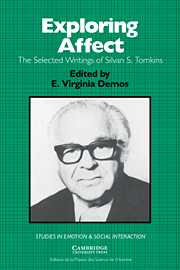Book contents
- Frontmatter
- Contents
- Foreword
- Editor's preface
- List of contributors
- Chronology
- Introduction
- Part I Affect theory
- Introduction
- Selections by Silvan S. Tomkins
- Part II Affect and ideology
- Introduction
- Selections by Silvan S. Tomkins
- Part III The face of affect
- Introduction
- Selections by Silvan S. Tomkins
- What and where are the primary affects? Some evidence for a theory (with Robert McCarter)
- The phantasy behind the face
- The role of facial response in the experience of emotion: A reply to Tourangeau and Ellsworth
- Inverse archaeology: Facial affect and the interfaces of scripts within and between persons
- Part IV Script theory: The differential magnification of affect
- Introduction
- Selections by Silvan S. Tomkins
- Part V Human being theory: A foundation for the study of personality
- Introduction
- Selections by Silvan S. Tomkins
- A complete annotated bibliography of Silvan S. Tomkins's writings
- References
- Author index
- Subject index
- Titles in the series
The role of facial response in the experience of emotion: A reply to Tourangeau and Ellsworth
Published online by Cambridge University Press: 10 November 2010
- Frontmatter
- Contents
- Foreword
- Editor's preface
- List of contributors
- Chronology
- Introduction
- Part I Affect theory
- Introduction
- Selections by Silvan S. Tomkins
- Part II Affect and ideology
- Introduction
- Selections by Silvan S. Tomkins
- Part III The face of affect
- Introduction
- Selections by Silvan S. Tomkins
- What and where are the primary affects? Some evidence for a theory (with Robert McCarter)
- The phantasy behind the face
- The role of facial response in the experience of emotion: A reply to Tourangeau and Ellsworth
- Inverse archaeology: Facial affect and the interfaces of scripts within and between persons
- Part IV Script theory: The differential magnification of affect
- Introduction
- Selections by Silvan S. Tomkins
- Part V Human being theory: A foundation for the study of personality
- Introduction
- Selections by Silvan S. Tomkins
- A complete annotated bibliography of Silvan S. Tomkins's writings
- References
- Author index
- Subject index
- Titles in the series
Summary
This is a reply to R. Tourangeau and P. C. Ellsworth's article, “The Role of Facial Response in the Experience of Emotion” Those authors tested a hypothesis about the role of voluntarily innervated facial responses in the experience of emotion and disconfirmed that hypothesis. My theory would also have predicted that their hypothesis would be disconfirmed. The value of the technique of voluntary simulation of facial responses for the study of innate affects is seriously questioned.
Tourangeau and Ellsworth (1979) have tested a hypothesis about the role of voluntarily innervated facial responses in the experience of emotion and disconfirmed that hypothesis. My theory (Tomkins, 1962) would also have predicted that their hypothesis would be disconfirmed. Although the authors do not claim that they are involved in a crucial test of my theory, nonetheless their conclusion might lead readers to believe that they had, in fact, disconfirmed the theory, since in their summary they say: “The effect of the stimuli does not, as the facial feedback hypothesis predicts, depend on the facial response” (p. 1530). This is a familiar example of a chronic malaise: summarizing more than one has demonstrated.
Tourangeau and Ellsworth are aware that they are testing something other than my theory, and they oscillate among saying so explicitly, saying that their hypothesis is really a necessary derivative of that theory, and saying that if I don't myself assert their hypothesis, that I ought to.
- Type
- Chapter
- Information
- Exploring AffectThe Selected Writings of Silvan S Tomkins, pp. 279 - 283Publisher: Cambridge University PressPrint publication year: 1995



